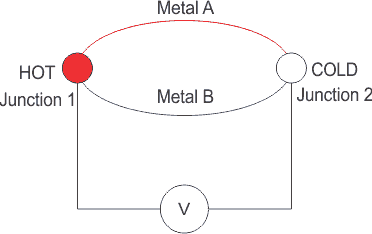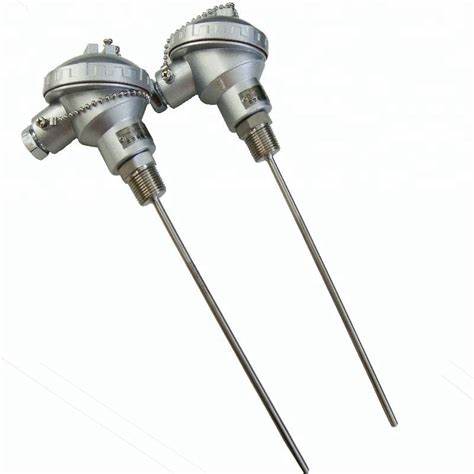What are Temperature Sensors?
Temperature Sensors are devices used to measure the temperature of an object, environment, or system. This information is then converted into an electrical signal that can be measured or processed by an instrument, controller, or display.
How do Temperature Sensors Work?
The basic principle of a temperature sensor is the Seebeck Effect. The Seebeck Effect is defined as the generation of an electric potential (or voltage) across two different conductors or semiconductors that are connected in a loop and have a temperature difference between their junctions. (Picture provided below of illustration).

As the materials in junction 1 are heated, the electrons gain energy and move from the hot area to junction 2, the cool area. This movement generates an electrical current, or flow of electrons. The Seebeck Effect requires two different materials because different materials have different numbers and types of electrons available for conduction. Some materials have more electrons than others, and some materials have electrons with different spins. When two materials with different electron characteristics are joined together, they form an interface where electrons can exchange energy and spin.
Another result of the material being heated is that its electrical resistance increases. The electrical resistance of the material increases because as the material is heated electrons gain more energy and vibrate faster. Thus, the flowing electrons are more likely to be repulsed by existing excited electrons. A real-world example would be that kicking a field goal in football is much easier when there is not a defender flailing their arms in front of the kicker. The same is true for electrons, if the temperature were to drop to absolute zero (no atomic motion), the resistance would be very low, as the electrons would not encounter the random motion of other electrons/atoms and could flow more easily.
What are Different Types of Temperature Sensors?
- Thermocouples
- How it works: A thermocouple consists of two different metals joined at one end, forming a junction. When this junction is heated or cooled, the metals create a small voltage that is proportional to the temperature difference between the junction and the other ends of the wires.
- Thermistors
- How it works: A thermistor is a type of resistor whose resistance changes significantly with temperature. Their resistance can either increase (positive temperature coefficient, or PTC) or decrease (negative temperature coefficient, or NTC) as the temperature changes.
- Resistant Temperature Devices (RTDs)
- How it works: An RTD measures temperature by utilizing the property that the electrical resistance of certain materials increases in a very predictable way with temperature. The resistance at a given temperature is measured, and using a calibration curve, the corresponding temperature is determined.
Where are Temperature Sensors Used?
Temperature sensors can be found in a wide range of applications and across many industries. Provided below are just a few examples of where temperature sensors can be found in everyday life.
- Industrial Applications: Manufacturing, energy generation, oil and gas, HVAC systems, and automated systems.
- Automotive Industry: Engine temperature monitoring, battery temperature, and climate control.
- Medical Applications: thermometers, incubators, medical devices such as dialysis, anesthesia, and blood warmer devices.
- Aerospace and Aviation: Aircraft engines, environmental control, and weather monitoring.
- Scientific Research: Laboratories, environmental monitoring, and particle accelerators.
- Energy and Utilities: Solar power systems, electrical grid, and thermal storage.
- Food Industry: Cold chain management, cooking and processing, and storage facilities.
- Building and Construction: Building materials and energy management.

